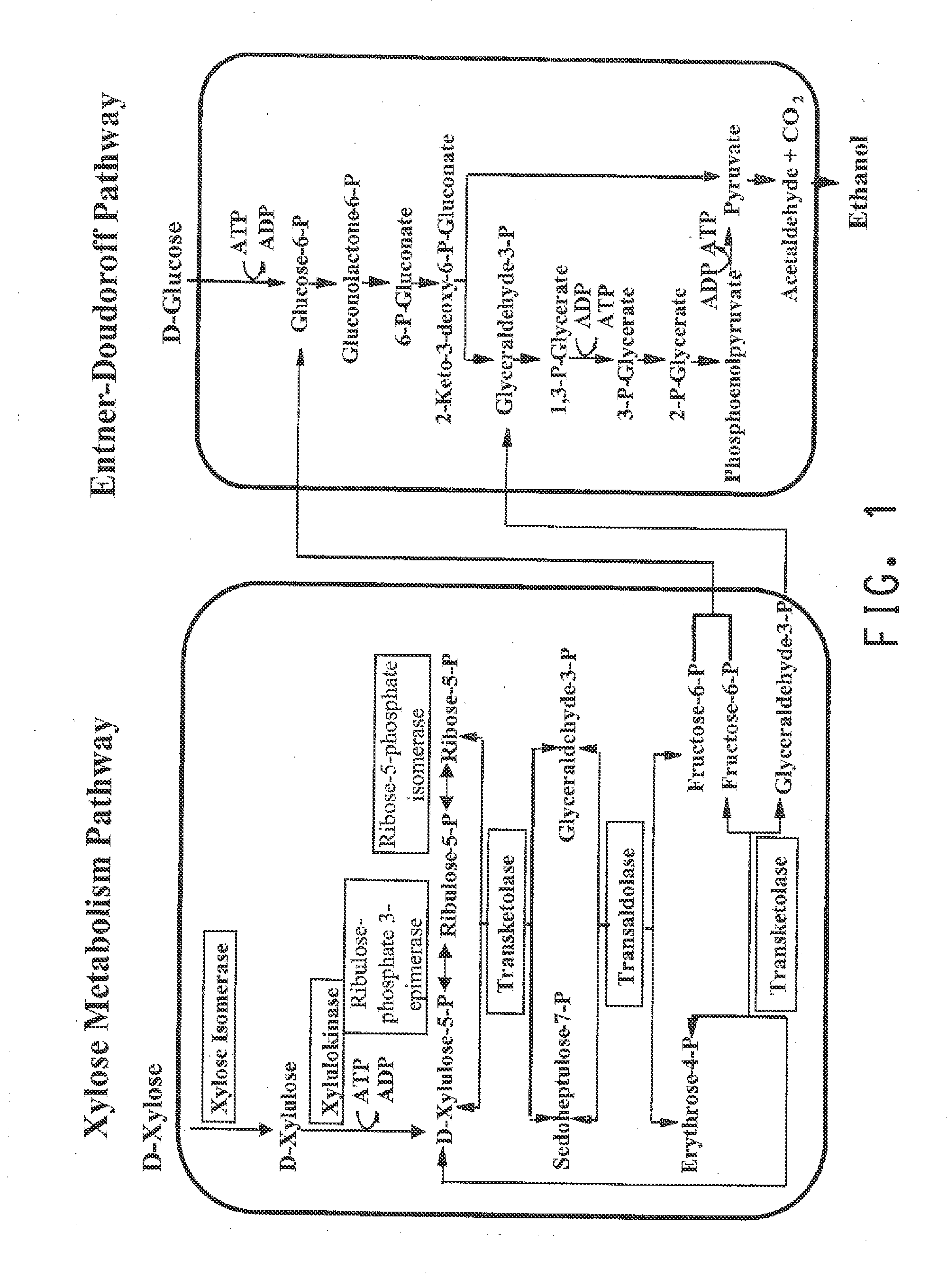Pnp gene modification for improved xylose utilization in zymomonas
a technology of zymomonas and xylose, which is applied in the field of microbiology and genetic engineering, to achieve the effects of improving xylose utilization and ethanol production in xylose-containing media, increasing ribose-5-phosphate isomerase activity, and non-limiting xylose isomerase activity
- Summary
- Abstract
- Description
- Claims
- Application Information
AI Technical Summary
Benefits of technology
Problems solved by technology
Method used
Image
Examples
example 1
Construction of pMODlinker-Spec-GapRPi
[0172]pMODLinker-Spec-GapRpi (FIG. 2) is a plasmid that can be used to generate a transposon that contains a Z. mobilis RPI expression cassette and a lox-flanked Spec-resistance cassette. The Z. mobilis RPI expression cassette was generated by PCR using plasmid pZB188aadA / Gap / Zymo RPI / EcoliSL as a template. The latter plasmid is described in U.S. Pat. No. 7,989,206, which is incorporated herein by reference. It contains an expression cassette for the Z. mobilis ribose 5-phosphate isomerase (RPI), that consists of (from 5′ to 3′) a full-length 641 GAP promoter sequence, the entire open reading frame of the Z. mobilis RPI gene (SEQ ID NO:13), and the XylA stem-loop region that is present in the intergenic region of the E. coli XylA / B operon. The entire RPI expression construct described above (SEQ ID NO:22) is located between the unique NcoI and NotI sites of plasmid pZB188aadA / Gap / Zymo RPI / EcoliSL.
[0173]A PCR-generated DNA fragment containing thi...
example 2
Overexpression of RPI in ZW801-4: Generation and Characterization of the I Strain
[0175]A transposon generated from pMODlinker-Spec-GapRpi (Example 1) was introduced into strain ZW801-4 (see General Methods) to increase RPI expression. The transposable element in this plasmid that randomly integrates into DNA after conversion to a transposome is the entire DNA fragment that is situated between two mosaic ends (ME) in the vector, which includes both the Z. mobilis RPI expression cassette and the Specr-cassette. The transposome was generated in vitro essentially as described in U.S. Pat. No. 7,989,206 using the general protocol that is outlined in the EPICENTRE® instruction manual for the EZ::TN™pMOD™-2 Transposon Construction Vector (Cat. No. MOD0602). The resulting transposome was electroporated into ZW801-4 cells and transformants were recovered on MMG and MMX (same medium with 50 g / L xylose instead of 50 g / L glucose) agar plates that contained spectinomycin (200 μg / ml). Since the t...
example 3
Overexpression of E. coli Xylose Isomerase in B9, B11 and I Strains
[0179]Although B9, B11 and I strains performed very similarly in the shake flask experiments with glucose and xylose as described above, subsequent experiments revealed an important difference between the I strain and the other two strains that also have an integrated copy of the RPI expression transposon. This difference was found by assessing whether higher expression of xylose isomerase in the 3 strains would result in a further increase in the rate of carbon flux through the engineered xylose pathway.
[0180]Xylose isomerase was the rate-limiting enzyme for xylose metabolism in strain ZW641, which was overcome in strain ZW658 by a point mutation in the Pgap promoter that drives the E. coli XylA / B operon, which resulted in increased expression of xylose isomerase (see strain construction in General Methods). As disclosed in commonly owned and co-pending U.S. patent application Ser. No. 13 / 161,734, published US201201...
PUM
| Property | Measurement | Unit |
|---|---|---|
| temperature | aaaaa | aaaaa |
| temperature | aaaaa | aaaaa |
| temperature | aaaaa | aaaaa |
Abstract
Description
Claims
Application Information
 Login to View More
Login to View More - R&D
- Intellectual Property
- Life Sciences
- Materials
- Tech Scout
- Unparalleled Data Quality
- Higher Quality Content
- 60% Fewer Hallucinations
Browse by: Latest US Patents, China's latest patents, Technical Efficacy Thesaurus, Application Domain, Technology Topic, Popular Technical Reports.
© 2025 PatSnap. All rights reserved.Legal|Privacy policy|Modern Slavery Act Transparency Statement|Sitemap|About US| Contact US: help@patsnap.com



